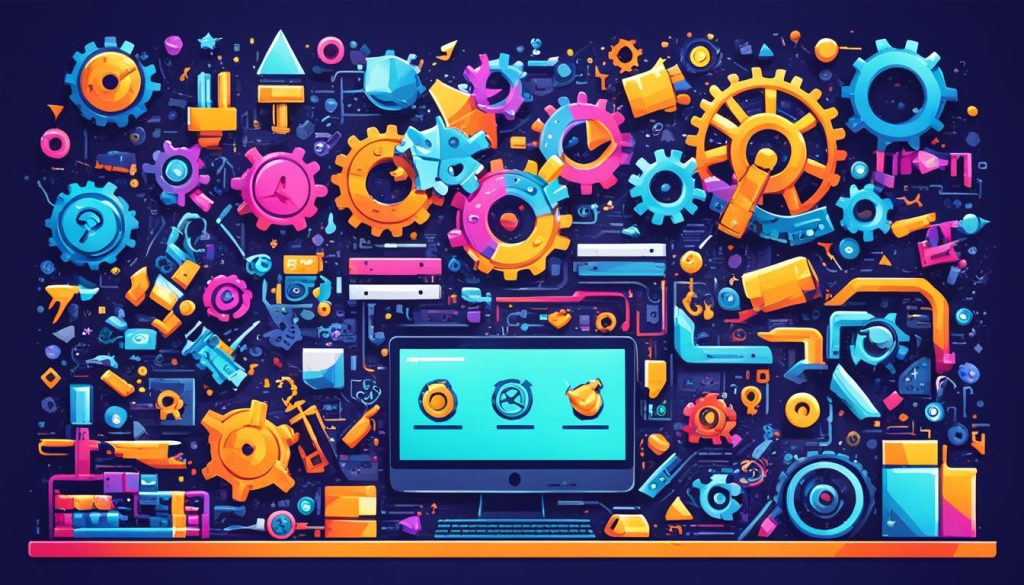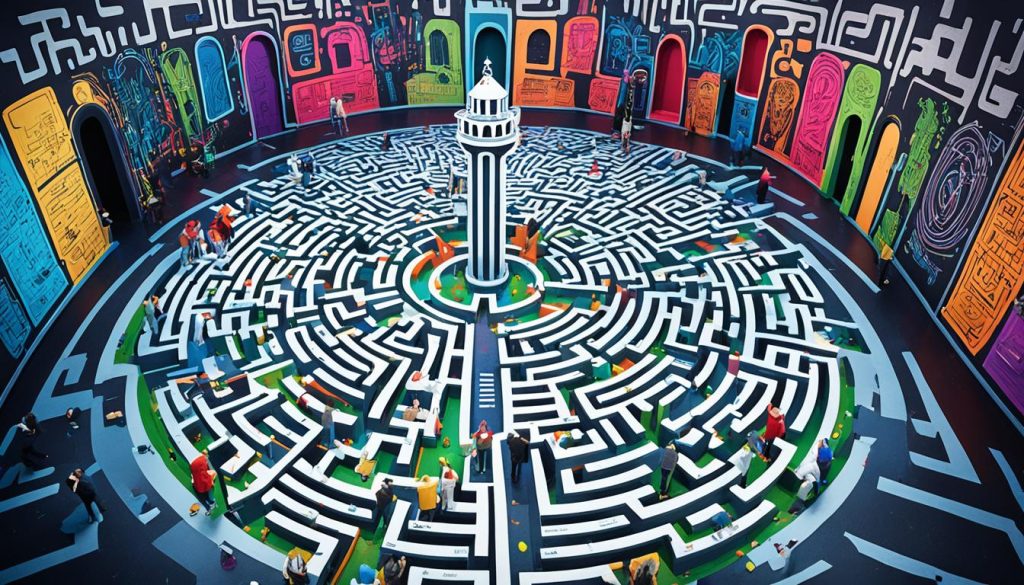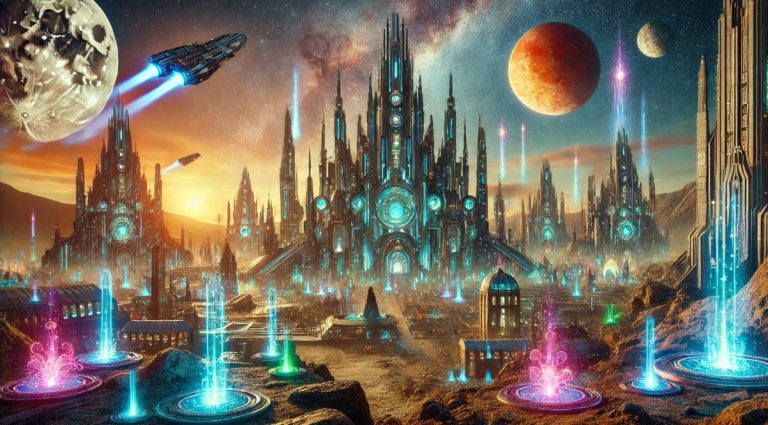Welcome to the world of game development! If you’ve ever dreamed of creating your own game, you’re in the right place. In this article, we will take you through the exciting journey of game development and unleash your creativity. Whether you’re a budding game developer or simply curious about the process, we have all the steps and tips you need to get started.
Game development is a fascinating blend of artistry and technical skills. It involves designing captivating gameplay experiences, implementing innovative game mechanics, and crafting visually stunning worlds. Alongside programming, storytelling, and visual design, collaboration and effective communication are key elements in the game development process.
So, how do you make a game? In the following sections, we will guide you through the essential steps of game development, covering everything from the basics to advanced techniques. You will learn about programming for game development, game design principles, art and visual design, collaboration in game development, and valuable tips and techniques to create successful games.
Whether you aspire to create indie games or work in the game industry, this article is your gateway to unlocking your game development potential. So, let’s dive in and discover the fascinating world of game development together!
The Basics of How to Make a Game
Game development is a fascinating process that requires a combination of skills in design, programming, storytelling, and art. Whether you’re dreaming of creating your own game or curious about the game development process, understanding the basics is essential for success.
Developing your own game starts with a solid foundation in the fundamentals. Learning about gameplay mechanics, user interfaces, and level design forms the building blocks of creating engaging experiences. It’s like laying the groundwork for a captivating journey that players will embark on.
Mastering the necessary skills and techniques allows aspiring game developers to bring their unique visions to life. By immersing themselves in the world of game development, they gain the ability to craft captivating narratives, design immersive game worlds, and create thrilling gameplay experiences.
Key Steps in the Game Development Process:
- 1. Conceptualizing your game idea
- 2. Creating a game design document
- 3. Developing game mechanics and prototyping
- 4. Designing engaging levels and challenges
- 5. Implementing and testing the game
- 6. Polishing and refining the gameplay experience
- 7. Launching and distributing the game
Throughout this process, the game developer wears multiple hats, seamlessly blending art, storytelling, and programming skills. It’s a dynamic and rewarding journey that allows for artistic expression while delighting players.
To illustrate the game development process visually, here is a table outlining the key steps:
| Steps | Description |
|---|---|
| Conceptualizing | Brainstorming and refining the game idea |
| Game Design Document | Creating a detailed plan for the game’s mechanics, story, and characters |
| Development | Implementing the game mechanics and creating prototypes |
| Level Design | Designing engaging levels, challenges, and puzzles |
| Testing | Identifying and fixing bugs, balancing gameplay elements |
| Polishing | Fine-tuning the game experience, adding visual effects and audio |
| Launch | Releasing the game and marketing it to the target audience |
A successful game development journey requires dedication, continuous learning, and a passion for creating memorable experiences. So, if you’re ready to embark on an exciting adventure in game development, start by mastering the basics and let your creativity soar!

Programming for Game Development
Programming is the foundation of game development, empowering developers to transform their ideas into reality through code. By learning programming languages such as C++, C#, or Python, you acquire the essential skills to create game mechanics, implement artificial intelligence, and build interactive environments. Understanding the basics of programming and utilizing game development tools is crucial in unlocking your creativity in the world of game development.
Game Coding Techniques
Game coding techniques are the building blocks that enable developers to design the functionality and behavior of their games. Here are some popular techniques used in game development:
- Collision Detection: This technique allows you to detect when objects in the game world come into contact with each other, enabling interactions and reactions.
- Pathfinding Algorithms: Pathfinding algorithms help characters or objects navigate through the game world, finding the most efficient routes to their destinations.
- Game Physics: Game physics enables realistic movement and interactions between objects, simulating gravity, collisions, and other physical forces.
- Optimization: To ensure smooth performance, optimizing code is essential. Techniques like code profiling and rendering optimization can enhance the game’s speed and efficiency.
By mastering these and other game coding techniques, developers can create immersive and engaging gameplay experiences for players.
Game Development Tools
Game development tools streamline the process of turning your ideas into playable games. Here are some essential tools used by game developers:
| Tool | Description |
|---|---|
| Game Engines | Game engines like Unity and Unreal Engine provide a framework to build and deploy games across multiple platforms, offering a range of features, including graphics rendering, physics simulations, and audio support. |
| Integrated Development Environments (IDEs) | IDEs such as Visual Studio and PyCharm offer a dedicated environment for writing, debugging, and testing game code, providing helpful tools and features to streamline the development process. |
| Version Control Systems | Version control systems like Git enable collaborative development, allowing multiple developers to work on the same project, managing code changes, and maintaining a history of revisions. |
| Asset Creation Software | Software like Photoshop, Maya, and Blender enable artists and designers to create and manipulate game assets, including characters, environments, textures, and animations. |
These game development tools enhance productivity and efficiency, enabling developers to bring their creative visions to life.

Game Design and Storytelling
Great games captivate players with compelling stories and immersive worlds. The art of game design involves creating engaging narratives, designing captivating characters, and developing exciting gameplay experiences. To create a successful video game, it is important to understand and implement game design principles that resonate with players and keep them engaged.
One of the key aspects of game design is understanding player motivation. By analyzing what drives players to continue playing a game, developers can create experiences that keep players hooked. Whether it’s progressing to the next level, unlocking powerful abilities, or solving intriguing puzzles, effective player motivation is essential for an engaging gaming experience.
Another important principle in game design is pacing. Pacing refers to the rhythm and flow of the game’s narrative and gameplay. It involves balancing moments of action and intensity with calmer, reflective periods. Well-paced games keep players engaged throughout their journey, ensuring a satisfying and immersive experience.
Progression is also a crucial element of game design. It involves guiding players through the game’s story and mechanics, gradually increasing difficulty and introducing new challenges to keep players challenged and interested. Effective progression allows players to feel a sense of achievement and growth as they advance in the game.
To master the art of storytelling and game design, developers can draw inspiration from successful games and study the techniques used to create emotional engagement. By examining how narrative, character development, and gameplay mechanics work together, developers can create memorable and emotionally immersive experiences for players.
Overall, by understanding and implementing game design principles such as player motivation, pacing, and progression, developers can create video games that captivate players and leave a lasting impression. Combining engaging narratives, well-designed characters, and thrilling gameplay experiences, developers have the power to create truly remarkable and immersive games.

Key Game Design Principles
| Principle | Description |
|---|---|
| Player Motivation | Understanding what drives players to continue playing and incorporating those elements into the game. |
| Pacing | Balancing moments of action and intensity with calmer, reflective periods to create a rhythm in the gameplay experience. |
| Progression | Guiding players through the game by gradually increasing difficulty and introducing new challenges. |
Art and Visual Design in Games
Visual aesthetics play a vital role in the creation of captivating games. From character design to environmental art and user interfaces, visual design sets the mood and enhances the player’s experience. By mastering art and visual design, developers can create visually stunning and immersive game worlds that engage players on a deeper level.
To bring their artistic vision to life, game developers need access to powerful game development software. These tools provide the necessary capabilities for creating and manipulating digital art, 2D and 3D models, textures, and animations. Leveraging game development software allows developers to refine their designs and ensure that every element of the game visualizes their creative intent.
Designing a game from scratch involves careful consideration of every visual aspect. Characters should be visually interesting and unique, with designs that reflect their personalities and roles within the game. Environmental art should be detailed and thoughtfully crafted to create immersive worlds that players can explore and interact with.
User interfaces are another critical aspect of visual design in games. They need to be intuitive, visually appealing, and seamlessly integrated into the game experience. A well-designed user interface enhances player engagement and ensures that players can easily navigate the game and access important information.
Beyond static visuals, animation breathes life into characters and game worlds. From smooth character movements to dynamic environmental effects, animation adds depth and realism to the game’s visual design. Mastering animation techniques allows developers to create visually fluid and captivating gameplay experiences.
Examples of Art and Visual Design in Games
Here are some games that showcase exceptional art and visual design:
- The Legend of Zelda: Breath of the Wild
- Horizon Zero Dawn
- Cuphead
- Journey
- Inside
Developing skills in art and visual design opens up a world of possibilities for game developers. By creating visually stunning and immersive game environments, developers can captivate players and deliver unforgettable gaming experiences.
Collaboration in Game Development
Game development is an intricate process that often requires the collaboration of multiple individuals with diverse skills and expertise. Working together as a team not only brings different perspectives to the table but also enables the creation of cohesive and polished games. In the realm of indie game development, collaboration plays a vital role in the game production process, allowing small teams to achieve big results.
When collaborating on game development projects, it is important to emphasize effective communication and teamwork. Clear and open lines of communication ensure that everyone is aligned and working towards a common goal. Regular team meetings, brainstorming sessions, and feedback loops enable the exchange of ideas, constructive criticism, and continuous improvement.
Collaboration extends beyond developers to include artists, musicians, and writers. Each team member adds their unique talents and perspectives, contributing to the overall vision and experience of the game. Whether it’s creating visually stunning artwork, composing captivating soundtracks, or crafting immersive narratives, the collective effort elevates the game to new heights.
Managing projects effectively is another crucial aspect of collaboration in game development. Breaking down the production process into manageable tasks, setting realistic deadlines, and tracking progress helps ensure smooth development processes and successful game releases. Utilizing project management tools, like Kanban boards or project trackers, enhances organization and facilitates efficient teamwork.
Version control is also essential in collaborative game development. By utilizing version control systems such as Git or SVN, developers can easily manage code changes, track revisions, and resolve conflicts. This enables seamless integration of different components of the game and simplifies the collaboration process, especially when multiple individuals are working on the same project simultaneously.
Benefits of Collaboration in Indie Game Development
In the world of indie game development, collaboration has several benefits that contribute to the success of the project:
- Shared Expertise: Collaborating with others allows you to tap into a diverse pool of skills and expertise, enhancing the overall quality of the game.
- Efficiency: By dividing tasks among team members, you can work more efficiently, ensuring that every aspect of the game is given the attention it deserves.
- Increased Creativity: Collaboration inspires creativity as team members bounce ideas off each other, fostering innovation and pushing the boundaries of game development.
- Motivation and Support: Working as part of a team provides motivation and support, making the development process more enjoyable and keeping morale high.
Overall, collaboration is a cornerstone of indie game development, allowing developers to leverage each other’s strengths, create synergistic experiences, and bring their creative visions to life.
Game Development Tips and Techniques
Creating a successful game requires more than just technical skills. Understanding the game market and implementing effective marketing strategies can make a significant difference in reaching your target audience. Here are some essential tips and techniques to level up your game development journey:
1. Know Your Audience
Before diving into game development, it’s crucial to identify your target audience. Conduct market research to understand their preferences, interests, and demographics. This knowledge will help you tailor your game to meet their expectations, resulting in a more engaging and enjoyable experience.
2. Implement Effective Marketing Strategies
Game marketing plays a vital role in promoting your game and attracting players. Utilize various marketing channels, such as social media platforms, online advertisements, and influencer collaborations, to increase awareness and generate buzz around your game. Consider implementing search engine optimization (SEO) techniques to improve your game’s visibility in search engine results.
3. Seek Feedback and Iterate
Feedback from players and fellow developers is invaluable in improving your game. Regularly test your game with a select group of target players and gather their feedback. Use this feedback to identify areas for improvement and iterate on your game’s mechanics, features, and overall experience. Continuously refining your game based on feedback will result in a more polished and enjoyable final product.
4. Stay Up-to-Date with Industry Trends
The game development industry is constantly evolving, with new technologies and trends emerging regularly. Stay informed about the latest industry developments, tools, and techniques by following game development blogs, forums, and attending industry events. Being aware of current trends will help you stay competitive and incorporate fresh ideas into your game.
5. Learn from Game Development Tutorials and Courses
Investing time in learning from experienced game developers through tutorials and courses is a smart move. These valuable resources provide insights into best practices, game design principles, programming techniques, and more. Take advantage of online platforms and educational institutions offering game development tutorials and courses to enhance your skills and gain new knowledge.
By implementing effective marketing strategies, seeking feedback from players, staying up-to-date with industry trends, and continuously learning from game development tutorials and courses, you can optimize your game development process and increase the chances of creating a successful and engaging game.
| Game Development Tips and Techniques | Benefits |
|---|---|
| Know Your Audience | Customize your game to meet players’ expectations |
| Implement Effective Marketing Strategies | Increase awareness and attract players |
| Seek Feedback and Iterate | Improve game mechanics and overall experience |
| Stay Up-to-Date with Industry Trends | Incorporate fresh ideas and stay competitive |
| Learn from Game Development Tutorials and Courses | Enhance skills and gain new knowledge |
Conclusion
Embarking on the journey of game development is an exhilarating adventure that combines creativity, technical prowess, and a deep love for gaming. By gaining a solid understanding of the foundations of game development, learning programming languages, delving into the intricacies of game design and storytelling, honing your artistic abilities, and embracing collaboration, you can unlock your potential to craft immersive and captivating interactive experiences.
To truly excel in the world of game development, it is essential to continuously enhance your skills and knowledge. Stay up-to-date with the latest industry trends, join game development courses, and actively participate in the vibrant community of game developers. By staying ahead of the curve, you can master the ever-evolving technologies and techniques that drive the creation of groundbreaking video games.
Remember, video game creation is not just a technical process, but an artistic one as well. Embrace your creativity, experiment with novel ideas, and push the boundaries of what is possible in game design. With passion, dedication, and a commitment to lifelong learning, you have the power to shape the future of gaming and leave a lasting impact on players worldwide. So, go forth, and let your imagination soar as you embark on your extraordinary journey in the realm of game development!
FAQ
How can I unleash my creativity in game development?
By understanding the basics of game development, learning programming languages, exploring game design and storytelling, honing artistic abilities, and fostering collaboration, you can unlock your potential to create your own interactive masterpieces.
How can I learn game development?
Joining game development courses, attending workshops, and staying updated with industry trends are great ways to enhance your skills and knowledge in this dynamic field of creativity and innovation.






